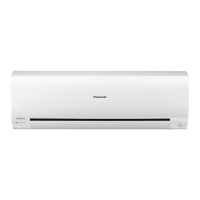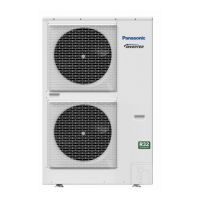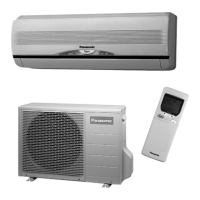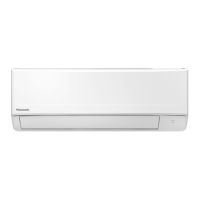1
1-11-28
2. SELECTING THE INSTALLATION SITE
2-1. Indoor Unit
AVOID:
● areas where leakage of flammable gas may be expected.
● places where large amounts of oil mist exist.
● direct sunlight.
● locations near heat sources which may affect the
performance of the unit.
● locations where external air may enter the room directly.
This may cause “condensation” on the air discharge ports,
causing them to spray or drip water.
● locations where the remote controller will be splashed with
water or affected by dampness or humidity.
● installing the remote controller behind curtains or furniture.
● locations where high-frequency emissions are generated.
DO:
● select an appropriate position from which every corner of the
room can be uniformly cooled.
● select a location where the ceiling is strong enough to
support the weight of the unit.
● select a location where tubing and drain pipe have the
shortest run to the outdoor unit.
● allow room for operation and maintenance as well as
unrestricted air flow around the unit.
● the limitation of the tubing length between the indoor and
the outdoor units should be referred to the Installation
Instructions of the outdoor unit.
● allow room for mounting the remote controller about 1 m off
the floor, in an area that is not in direct sunlight or in the flow
of cool air from the indoor unit.
4-Way Cassette Type
Wall
indoor unit indoor unit
min. 1 m
min. 1 m
Over 2.5 m
min. 3 m
Obstacles
Ceiling
1 m
1 m
1 m
1 m
281258_EU.indb 7 2016-9-1 13:03:39
6. LEAK TEST AND EVACUATION
Keep 3-way valve fully closed and pressurize through three-way valve service port.
Do not pressurize to the default value at once. Pressurize gradually.
1 Pressurize to 0.5MPa (5
f/cm
²
G) and then leave it for 5 minutes to ensure that the pressure does not drop.
2 Pressurize to 1.5MPa (15
f/cm
²
G) and leave it for 5 minutes to ensure that the pressure does not drop.
3 For the test, pressurize to 4.15MPa and leave it for about 1 day to ensure that the pressure does not drop.
R 3 2
Outdoor unit
3-way
valve
Indoor unit
Use nitrogen gas for the leak tightness test.
Using fl ammable gas can cause an explosion.
Pressure
meter
Nitrogen Refrigerant
meter
Vacuum
pump
Leak Tightness Test Method
Use a vacuum pump (with back-fl ow prevention device) to vacuum through the 3-way valve service port to achieve
the pressure below -101kPa (5 Torr).
Air and moisture remaining in the refrigerant system due to poor vacuum drying can cause performance decrement
and malfunction of the compressor.
Charging with refrigerant
Use tools that are designed specifi cally for R32, for pressure resistance and to prevent mixing impurities.
Fill the refrigerant from the 3-way valve’s service port on the liquid-side.
(For refi lling due to a leak)
For fi lling and replacing all refrigerant
For refi lling refrigerant, fi rst collect all residual refrigerant and after vacuum dehydration using the vacuum pump. Refi ll the refrigerant according to the prescribed amount stated
on the placard affi xed to this unit.
Precautions after the pipes’ connection have completed
Ensure to open the 3-way valve after completing the piping installation, leak test and vacuuming. If it is closed during operation, it can lead to compressor failure.
At the time of shipment from the factory, this unit is charged with enough refrigerant for an equivalent pipe length of 30m. If the equivalent pipe length used will be 30m or less,
no additional charging will be necessary.
If the equivalent pipe length will be between 30 and 50m, charge with additional refrigerant according to the equivalent length given in the table below.
For standard type
Pump down operation
Please refer to “9. PRECAUTIONS REGARDING TEST RUN (Caution for Pump Down)” of this Installation instruction manual. It is also indicated on the label affi xed to the
outdoor unit.
Ensure to fi ll only with liquid refrigerant when refi lling.
If gas refrigerant is fi lled, the refrigerant composition will not be balanced and will cause
abnormal operation.
Cylinder with
a siphon tube
Liquid refrigerant
Siphon tube
7. REGARDING REFRIGERANT FILLING
Precautions during refrigerant fi lling
If using cylinders as shown in the bottom left diagram; without a siphon tube
inside, turn it upside down and use it.
(It is recommended to use the manifold with the side glass.)
Cylinder
Cylinder
Gas refrigerant
Possible
Not possible
Liquid refrigerant
Additional charging amount Equivalent length Minimum length
U-100/125/140P 45
m5m05m/
EVACUATION
SM830266-00_大洋州向けR32シングルTD&SM.indb 28 18/03/29 10:20:16
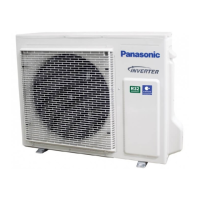
